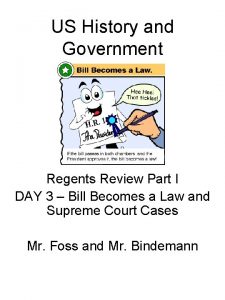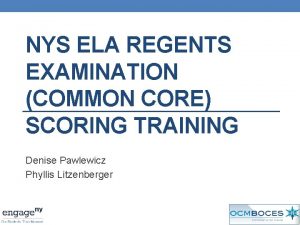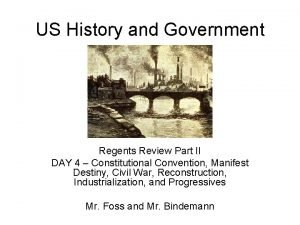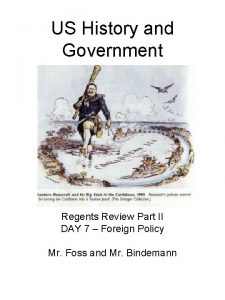US History and Government Regents Review Part I






- Slides: 6

US History and Government Regents Review Part I DAY 3 – Bill Becomes a Law and Supreme Court Cases Mr. Foss and Mr. Bindemann

Major Supreme Court Cases in American History Case: Marbury vs. Madison Date: 1803 Adam’s Midnight Appointments Significance: Judicial Review Case: Plessy vs. Ferguson Date: 1896 First Class Railcar Ticket Significance: Separate but Equal Case: Brown vs. Board of Education Date: 1954 Integration of School Significance: Separate but Equal is Unconstitutional Case: Miranda vs. Arizona Date: 1966 Self Incrimination and rights of the Accused Significance: Miranda Rights 5 th, 6 th, and 14 th (Due Process) Case: Gideon vs. Wainwright Date: 1963 Right to an attorney, 14 th and Significance: 14 th amendment guarantees due process in states Case: Mapp vs. Ohio Date: 1961 Search and Seizure Significance: 4 th and 14 th protect from warrantless searches

Major Supreme Court Cases in American History Case: Korematsu vs. United States Date: 1944 Equal Protection (14) vs Executive Powers Significance: Wartime “Clear and Present Danger” Case: Schenk vs. United States Date: 1919 Free Speech vs. Congressional Powers (Espionage) Significance: Clear and Present Danger (fire in a theater Case: United States vs. Nixon Date: 1974 Watergate and Executive Privilege Significance: Ruled against Nixon Case: New York Times vs. United States Date: 1971 Free Press vs. Executive Power Significance: Pentagon Papers (national security not risked Case: Dred Scott vs. Sanford Date: 1857 Citizenship and Slavery Significance: Slaves were considered property Case: TLO vs. New Jersey Date: 1985 4 th Amendment vs. Students Rights Significance: School Officials do not need warrant

Major Supreme Court Cases in American History Case: Vernonia vs. Acton Date: 1995 Student Searches and drug testing Significance: Student safety outweighed 4 th amendment Case: Schechter Poultry Co. vs. United States Date: 1935 Congressional Power vs. Presidential Power Significance: Congress regulates interstate commerce Case: Munn vs. Illinois Date: 1877 Free Enterprise vs. State Rights Significance: States can make laws for the good of its citizens Case: Ex. Parte Merryman Date: 1861 Suspension of Habeas Corpus (Trial and Due Process) Significance: Congress gave power to suspend H. C. during wartime Case: Roe vs. Wade Date: 1973 Women’s Right to Privacy and Personal Choice Significance: Right to Privacy and Personal Choice Make sure that you are an expert on at least two of these court cases!!!! Use 54, 55, and 56 from your notebook to help you

How a Bill Becomes a Law I. Bill Introduced into one chamber of Congress No Yes II. Bill goes to the other chamber of Congress Yes No III. No VETO Yes Bill goes to President IV. Bill Become a LAW 2/3 Override by both Chambers V. Supreme Court JUDICIAL REVIEW • Constitutional - the law stays • Unconstitutional means the law waves goodbye

Practice Questions











